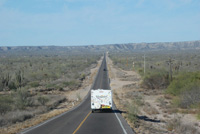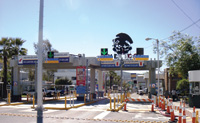(This is the second in a four-part series on RVing in Mexico)
 So, you have finally decided to expand your horizons by heading south of the border. Last month, I hope we convinced you that you can take your RV into Mexico with a reasonable degree of safety and confidence. Now comes the difficult part: navigating the rules and regulations on moving your RV and toys across the border. The good news if you are planning on traveling to Baja or no further south than Guyamos in Sonora State is that you will be in what Mexico describes as the “hassle-free zone.” No permits are required other than a tourist card. (For Baja travel information, see Dan Goy’s website at bajaamigos.net.).
So, you have finally decided to expand your horizons by heading south of the border. Last month, I hope we convinced you that you can take your RV into Mexico with a reasonable degree of safety and confidence. Now comes the difficult part: navigating the rules and regulations on moving your RV and toys across the border. The good news if you are planning on traveling to Baja or no further south than Guyamos in Sonora State is that you will be in what Mexico describes as the “hassle-free zone.” No permits are required other than a tourist card. (For Baja travel information, see Dan Goy’s website at bajaamigos.net.).
 The procedure for taking your RV into mainland Mexico is intimidating for the first-timer, and the purpose of this article is to try to provide the information required. Be assured that the first time is the most daunting. If you are traveling in a commercial caravan, the operators of the caravan will assist you with all of this. Make sure you take notes so you can do it on your own for later trips. Crossing with a caravan or others who have done it before is a huge advantage.
The procedure for taking your RV into mainland Mexico is intimidating for the first-timer, and the purpose of this article is to try to provide the information required. Be assured that the first time is the most daunting. If you are traveling in a commercial caravan, the operators of the caravan will assist you with all of this. Make sure you take notes so you can do it on your own for later trips. Crossing with a caravan or others who have done it before is a huge advantage.
The rules regarding vehicles, pets and importation in general are fluid and another new wrinkle may well be added before the next Snowbird season. I maintain a web page with the latest updates at mexicorvforums.com/border.html and I encourage you to check there for more details and the latest information.
Necessary Insurance
The first step is to ensure any vehicles are in your name and that anyone listed on the registration is traveling with you. If the vehicle is leased or in a company name (even your own), you need a notarized letter of permission (preferably in Spanish) to take it into Mexico. The same may be true if anyone listed on the registration is not traveling with you. Also ensure you have pre-purchased Mexican auto insurance with a minimum $500,000 liability.
 It is not a bad idea to take the originals of any documents they may even remotely ask for, including items such as birth certificates and marriage certificates if you have them. You will definitely need your passport, driver’s license, a credit card and original registrations for all vehicles, trailers and toys. Make two copies of each piece of documentation and have them with you. I also advise scanning all documentation and emailing them to yourself so you can readily access them online should you lose anything.
It is not a bad idea to take the originals of any documents they may even remotely ask for, including items such as birth certificates and marriage certificates if you have them. You will definitely need your passport, driver’s license, a credit card and original registrations for all vehicles, trailers and toys. Make two copies of each piece of documentation and have them with you. I also advise scanning all documentation and emailing them to yourself so you can readily access them online should you lose anything.
You will be required to pay a deposit of $200-$400, depending on the vehicle’s age, in cash or by credit card on each vehicle not classified as an RV. This includes pickups, towed cars and motorcycles over 150 cc. There are two classifications of permits. A “Casa Rodante” or Rolling Homes (RV) permit and a normal vehicle permit. Each traveler may have one of each type. Here are some examples; if you have a Class A with tow car, you will have one Casa Rodante permit and one vehicle permit. If you have a fifth-wheel, you will also require the same, a vehicle permit on the towing truck and a Casa Rodante on the trailer. If you have a Class A, B or C without a tow car, you will need a single Casa Rodante permit. To make things even more confusing, a Casa Rodante permit is good for 10 years, a vehicle permit only for 180 days.
You may attach up to three items to any permit. These include cargo and utility trailers, motorcycles under 150 cc’s and ATVs under 350 cc’s. Everything else requires its own permit. Depending on what is added to a Casa Rodante permit, it may only be valid for 180 days instead of 10 years. All permits must be canceled before expiry. The 10-year Casa Rodante permit is designed to enable you to store an RV in Mexico for a few seasons. Unless you intend to do that, my advice on a 10-year permit is to cancel it every time you leave Mexico unless you live close to the border. If you sell the RV or write it off at home, you will not be allowed to take another RV into Mexico until the old permit is canceled.
Trip to the Bank
All vehicle permits are handled by the Mexican bank, Banjercito. This means that the permit offices are not usually a part of the customs procedure when crossing the border itself. I advise obtaining a copy of the book Mexican Camping by Mike and Terri Church, available from rollinghomes.com. This book has detailed information on each crossing. For those of us in the West, I suggest using the Nogales Mariposa truck crossing (do not use downtown Nogales) south of Tucson and I will use that particular crossing to describe the procedures. The customs inspection station is 10 kilometers south of the border, and you will experience the “red light-green light” routine to determine whether or not you will be searched, asked for pet certificates, etc. The Banjercito complex where you obtain your tourist card and permits is 21 kilometers south of the border on the right-hand side. Make sure you cross with at least 2,000 pesos to handle tolls and fuel for your first day. Using U.S. dollars in Mexico is becoming increasingly difficult, but ATMs are widespread.
Upon arriving at the permit center south of Nogales, you must initially go into the trailer closest to the parking lot and obtain your tourist card. Be prepared to tell them what your destination is. Make one up if you don’t know. Next walk l00 feet south to the Banjercito windows, pay for your tourist card and obtain your vehicle permit. Take all your original documentation and copies with you. If you have to pay a vehicle deposit you must do so with U.S. cash or a credit card. You will be rebated, in same, when you exit Mexico. Do not lose any receipts they give you. You will be issued one or both types of permits, complete with a hologram to affix to your windshield. Do not throw out the piece of paper they are attached to; you will be asked for it when you exit Mexico. You will pay around $45 for each tourist card and each permit. Return to the first building to prove you have paid for your tourist card and have it validated.
You may obtain vehicle permits ahead of time online, but you still have to deal with the tourist card in person. I advise against obtaining permits online unless you live close to the border, or you are 100 percent certain you will not cancel your trip. Permits are incredibly difficult to cancel by mail. The links, procedures and forms may be found on my aforementioned web page.
There are some gray areas, notably truck campers, which they may classify either as truck carrying cargo or as an integrated RV. Camper vans are another gray area. Check my web page for details if you have either type.
When you exit Mexico, you must return to a Banjercito center (not necessarily the same one) and cancel your permit. You will be issued a receipt. Do not lose it; it is your proof the vehicle left Mexico. Remember if you do not cancel a permit, you may not be allowed to bring a vehicle into Mexico in the future.
What about pets? If you have a pet, you now require two copies of a Certificate of Health from your vet showing his license number and address. The pet has to have up-to-date shots and a rabies certificate. Your odds of being asked are slim, but be prepared. Only dogs and cats are allowed into Mexico. No snakes, birds, hamsters, etc.
Now I am sure you have a splitting headache. I can assure you that the second time is far easier. Please feel free to contact me with your individual situation. I am happy to assist.
In the next issue, my colleagues, Dan and Lisa Goy, will write about Baja. I will return in October with an article about what is unique about RVing in Mexico.
Paul Beddows is former president of the North American Truck Camper Owners Association (NATCOA) and works with Caravanas de Mexico RV Caravans (mexicorvbuddies.com). He has spent many years RVing in Mexico and may be contacted at paul@natcoa.com.

Hi
We are a swiss couple travelling to Mexico with our converted van. We try to get the casa rodante permit for 10 years. But we heared, that some people with converted vans where refused for the casa rodante permit. This is why i was reading you post, but unfortunately I cannot find the link on your webside to which you rever to in the following aticle: http://rvlife.com/crossing-into-mexico-in-an-rv/
“There are some gray areas, notably truck campers, which they may classify either as truck carrying cargo or as an integrated RV. Camper vans are another gray area. Check my web page for details if you have either type.”
Maybe you can give me the link or maybe you have some more experience about casa rodante permit and the allowance of converted vans.
Thank`s a lot for your help.
Stefanie
Hi there,
We are a couple from England, who have travelled to Baja California many times.
We are looking to purchase an RV in San Diego and drive it down to leave in storage in BCS for our use when we are there, two or three months a year.
Can you advise please.
Whether we can get through the border with the RV transfer of ownership documents acquired immediately after purchasing the RV.
What documentation we would need in order to cross permanently into BCS.
Kind regards,